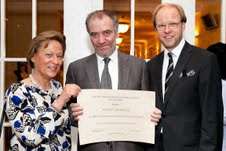|
Back
Gergiev and Capuçon with the London Symphony Orchestra Vienna
Konzerthaus
05/21/2012 -
Piotr Ilyitch Tchaikovsky: Overture to Rome and Juliet – Variations on a Rokoko Theme for violoncello and orchestra, op. 33
Igor Stravinsky: Le Sacre du printemps
Gautier Capuçon (violoncello)
London Symphony Orchestra, Valery Gergiev (conductor)

V. Gergiev (© Alberto Venzago)
“There is no more obvious expression of power than the performance of a conductor” Nobel Prize winner Elias Canetti wrote in his 1960 book “Crowds and Power”. But what is it exactly that a conductor does? And what is it that makes a good conductor a great maestro? There have been many attempts to demystify this anachronistic profession, some of them rather amusing. There are few conductors today who fuel that perennial discussion more than Russian Maestro Valery Gergiev, with his rather un-orthodox, quite unique conducting style.
Gergiev, the mysterious maestro from the Caucasus, serves currently as Music Director of both the Mariinsky Theater in St. Petersburg as well as the London Symphony Orchestra. He is also Artistic Director of several prestigious music festivals worldwide. This was the first time the London Symphony performed under Gergiev’s baton (although he doesn’t use one!) in Vienna. After the first night’s concert, also featuring works by Tchaikovsky and Stravinsky, Maestro Gergiev was induced into the Konzerthaus “Hall of Fame”: he was awarded the Honorary Membership of the prestigious Vienna Konzerthaus Society. In his eulogy Konzerthaus Intendant Bernhard Kerres praised Valery Gergiev’s outstanding contribution to the cultural life of St. Petersburg as well as his exemplary support for young artists.

(© Ludwig Schedl)
The newly appointed honorary member of the Konzerthaus Society opened the program for the second night of this mini concert cycle with Tchaikovsky’s Fantasy Overture Romeo and Juliet. Valery Gergiev raised his arms – and with the mysterious flickering of his fingers the woodwinds even more mysteriously began the introduction with utmost precision. A couple of bars later, the strings responded to the nervously flickering hands with a pizzicato as precise and together as I have hardly ever heard before. I soon decided to give up deciphering how this conductor “does it”, and instead to just sit back and enjoy Tchaikovsky’s masterpiece. Overall, Gergiev displayed a penchant for slow tempi with which he builds and sustains long lines of tension. The orchestra always maintained a well-balanced sound, never forcing their instruments, even in the most fortissimo brass passages.

G. Capuçon (© Julie Mignot)
30-year-old Frenchman Gautier Capuçon is, despite his tender age, one of the leading cellists of our time. Walking on stage, his delicate demeanor contrasted with the almost demonic aura of the 6-foot conductor. Nevertheless, they made a perfect team for Tchaikovsky’s Variations on a Rokoko Theme. Capuçon not only possesses with his 1701 Gofriller cello one of the most perfect instruments ever built, but he also knows how to get the best out of it. Already with the opening theme, he enthralled the audience by the sheer beauty of his playing. If his sound was somewhat sweet at the beginning, it became fuller and deeper as the variations progressed. Valery Gergiev and the London Symphony were ideal partners for Capuçon and gave him reliable support.
The audience in the sold-out Konzerthaus went crazy after Gautier Capuçon ended his last variation at break-neck speed. Capuçon and Gergiev chose Tchaikovsky’s Andante Cantabile as encore. Capuçon, with his stunning bow technique, can work magic!
The program concluded with Stravinsky’s Sacre du printemps. You could not have wished for a more congenial conductor for this piece. And, the conductor could not have wished for a better orchestra to play it. The London Symphony lived up to its reputation of being one of the world’s leading orchestras. It was the perfect canvas for Valery Gergiev to “paint” his depiction of Stravinsky’s groundbreaking 20th century masterpiece. Gergiev used strong, even harshly contrasting colors: the whole range, from watercolors over gouache to oil, from pencil to neon markers. The resulting Sacre was truly memorable!
Gergiev and his London Symphony Orchestra acknowledged the thunderous applause with the “March” from Prokofiev’s Love for Three Oranges.
A Russian conductor, a British Orchestra and a French cellist, all celebrating music in Austria? If only other aspects of European interaction could be as successful...
Wiebke Kuester
|